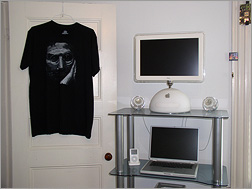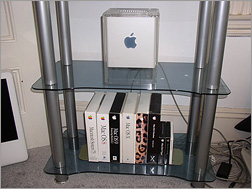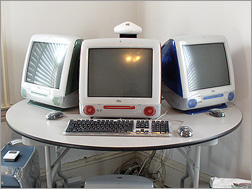PowerPC G-Series
Post-NeXT and the Second Jobs Dynasty
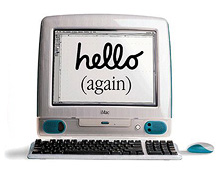
iMac – 1998
Whimsical and relatively cheap ($1299), the original iMac marked Apple’s new design direction and return to profitability in the Second Jobs Dynasty. Gone were “boring beige boxes” and legacy technologies like the floppy disk, ADB and SCSI; the iMac was a “New World” G3-based system and introduced USB to the Mac faithful. The iMac captured the spirit of the original compact Mac, was easy to use and distinctly different from anything else on the market – a once and soon-to-be-again Apple trait. The iMac’s importance to Apple earns this model an honorable inclusion in the VMM in spite of that unfortunate bondi blue color and the “puck mouse” debacle.
VMM TV : Say Hello to iMac
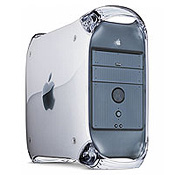
PowerMac G4 “Graphite” (AGP) – 1999
Combining iterations made since the beige G3 series, Apple finally hit a design and stylistic home run with the PowerMac G4 AGP-Graphics series. These “Graphite” models inherited the highly serviceable fold-down side design of the earlier G3 and G4 towers, had faster system and graphics buses, fit 4 internal hard drives, and sported a very elegant color scheme suitable for professional environments. The AGP line existed for several years in many different model configurations, eventually evolving into the QuickSilver case (but losing the CD eject button… sigh). Aftermarket G4 upgrade cards kept these models productive well past their normal retirement ages. VMM TV: PowerMac G4 “Weapon”
PowerMac G4 Cube – 2000
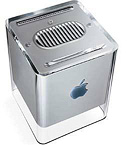 Steve Jobs loves cube shaped computers. He first designed one for NeXT, which was an aesthetic success but a commercial failure. His second attempt for Apple fared similarly, but has obtained collector status due to the beauty and novelty of the design. The Cube is 8″ tall and passively cooled for silent operation (fans are a longstanding peeve of Steve). However, its limited expansion capability and premium price led to slow sales as users felt bang for the buck was lacking. Apple finally got the small headless Mac tradeoff right a few years later with the mini, itself a third the size of the Cube with more power at a lower cost.
Steve Jobs loves cube shaped computers. He first designed one for NeXT, which was an aesthetic success but a commercial failure. His second attempt for Apple fared similarly, but has obtained collector status due to the beauty and novelty of the design. The Cube is 8″ tall and passively cooled for silent operation (fans are a longstanding peeve of Steve). However, its limited expansion capability and premium price led to slow sales as users felt bang for the buck was lacking. Apple finally got the small headless Mac tradeoff right a few years later with the mini, itself a third the size of the Cube with more power at a lower cost.
The VMM G4 Cube runs Mac OS X 10.4.11 and serves as the central file server for Oakbog and the Museum. Tiger is a good choice for this function since it’s version of AppleShare IP can communicate with all versions of Mac OS from System 7.5.3 through to the latest OS X release.
VMM Blog: Vintage Mac Museum Workhorse – PowerMac G4 Cube

iMac DV and the OS X Evolution
New products often take a generaton or two to work out the bugs, and the iMac was no exception. With the introduction of the DV series of slot loading iMacs (G3 400MHz and faster) Apple finally offered useable processing power at a low price – down to $799 at one point. It also came in a mature and refined case with much less garish colors – Flower Power & Dalmation notwithstanding. FireWire ports for DV video production, DVD/CD-RW drives, and the same fanless design as the G4 Cube rounded out the experience. The iMac DV is an excellent Mac OS 9 machine, and with some extra added RAM makes an adequate (if pokey) Mac OS X system.
iMac DV systems play a special role in the Museum showcasing the evolution of Mac OS X: Sage, Ruby and Indigo units are loaded with Mac OS X 10.0.4 (Cheetah), 10.1.5 (Puma) and 10.2.8 (Jaguar) respectively.
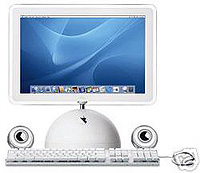
iMac G4 – 2002
Flat Out Cool! That’s how Time magazine described the iMac G4 when it was introduced. A radical departure from previous designs, Apple (and specifically designer John Ive) were hitting on all cylinders. The R2-D2’esque “iLamp” had FireWire, USB, and a 15″, 17″ or 20″ screen that floated lightly on a lamp-like swing arm for easy positioning. The design did have some limitations – its difficult to open for servicing and the eyeball speakers add an extra item to your desktop – but in this writer’s opinion it’s one of Apple’s most elegant designs ever.
At the VMM a 17″ iMac G4 runs Tiger with Mac OS 9 in “Classic” mode, to allow Filemaker Pro v4 software to print to an old CD printer via a USB-to-Serial-Port adapter. Who says 10 year old peripherals can’t still be useful?
VMM TV : iMac G4 “Window”
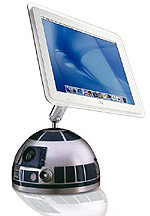
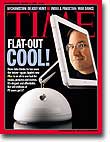
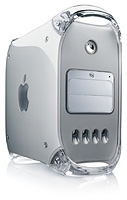
PowerMac G4 MDD “Wind Tunnel” – 2002
An evolutionary model, the PowerMac G4 MDD (Mirrored Drive Doors) featured dual processors in a sturdy redesigned tower that now offered two 5.25″ front drive bays, 3 IDE buses and and 4 internal hard disks. The excellent fold-down side design was retained, and even the notoriously sluggish Mac OS X felt snappy on these systems. Cooling was beginning to become an issue with faster CPU speeds, and some configurations had problems with very loud fans. The press quickly adopted the moniker “wind tunnel” and the nickname stuck. Fixes in subsequent OS releases largely resolved the problem. This is the last series of PowerMacs which can be dual-booted into Mac OS 9 and Mac OS X; newer models are OS X only.
VMM Blog: Reinstalling Mac OS 9 on a PowerMac G4 MDD
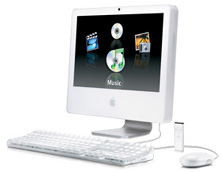
iMac G5 – 2004
Sensing a slowdown in iMac G4 sales, and addressing some of that model’s design flaws, the iMac G5 came in 17″ and 20″ models with very good cost/performance ratios. Apple trumpeted the easy to service features for adding RAM and swapping hard drives, and many people just looked at the screen and asked where’s the computer? Oddly, the second iteration of the iMac G5 was less user-serviceable than the first; in hindsight it’s likely they were prepping the case for the upcoming (but as-yet-unannounced) Intel CPU change. Front Row media center software debuted on this model, complete with an IR remote control reminiscent of the MacTV.
Unfortunately as they age the iMac G5 has had problems with overheating and bad capacitors, and this model has not weathered the test of time well. Still, if Apple had made this iMac in black I would have purchased one immediately…

Mac mini G4 – 2005
Finally achieving commercial success with a cube-like system on the third attempt, the Mac mini was Apple’s minimalist answer to everybody who always pestered them for a $500 Mac. Sold CPU only (bring-your-own keyboard, mouse and monitor), the mini’s small size and decent performance made it a practical desktop system, living room media center or a cheap headless server. It was also popular among car stereo designers – the case fits nicely into a car radio dashboard slot!
Despite an unnecessarily hard to open case the mini was quite popular, and the form factor has survived the transition into the Intel CPU lineup. The VMM mini runs Leopard, the final release of Mac OS X that supports PowerPC Macs. VMM TV: Switch (Ellen Feis)
Xserve G4/G5, Mac OS X Server – 2002
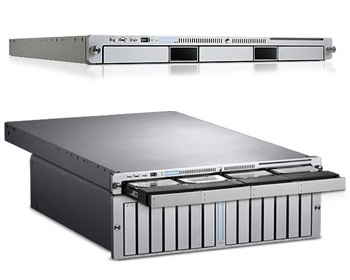 Apple had offered server configurations of their systems in the past, but they were basically souped-up versions of existing towers with AppleShare Server and additional software installed. The Xserve represented a completely new form factor designed specifically to be a rack-mount unit and work well in corporate server environments. The stylish enclosure supported up to 4 internal drives (G4 models), dual ethernet connectors, remotely controllable status lights (on the front and back panels) and 64-bit multiprocessor support (G5 models). They retained compatibility for existing 32-bit Mac software, had external Apple hardware RAID expansion options, and came in primary server and cluster node configurations. Mac OS X Server software supported many functions for email, FTP, web hosting and mixed Mac-Windows file sharing environments.
Apple had offered server configurations of their systems in the past, but they were basically souped-up versions of existing towers with AppleShare Server and additional software installed. The Xserve represented a completely new form factor designed specifically to be a rack-mount unit and work well in corporate server environments. The stylish enclosure supported up to 4 internal drives (G4 models), dual ethernet connectors, remotely controllable status lights (on the front and back panels) and 64-bit multiprocessor support (G5 models). They retained compatibility for existing 32-bit Mac software, had external Apple hardware RAID expansion options, and came in primary server and cluster node configurations. Mac OS X Server software supported many functions for email, FTP, web hosting and mixed Mac-Windows file sharing environments.
The G5 Xserve was replaced by the Intel-based Xeon model in 2006, using the same form factor. Definitely a well-thought out and sturdy design. VMM Blog: The PowerPC Bows Out

